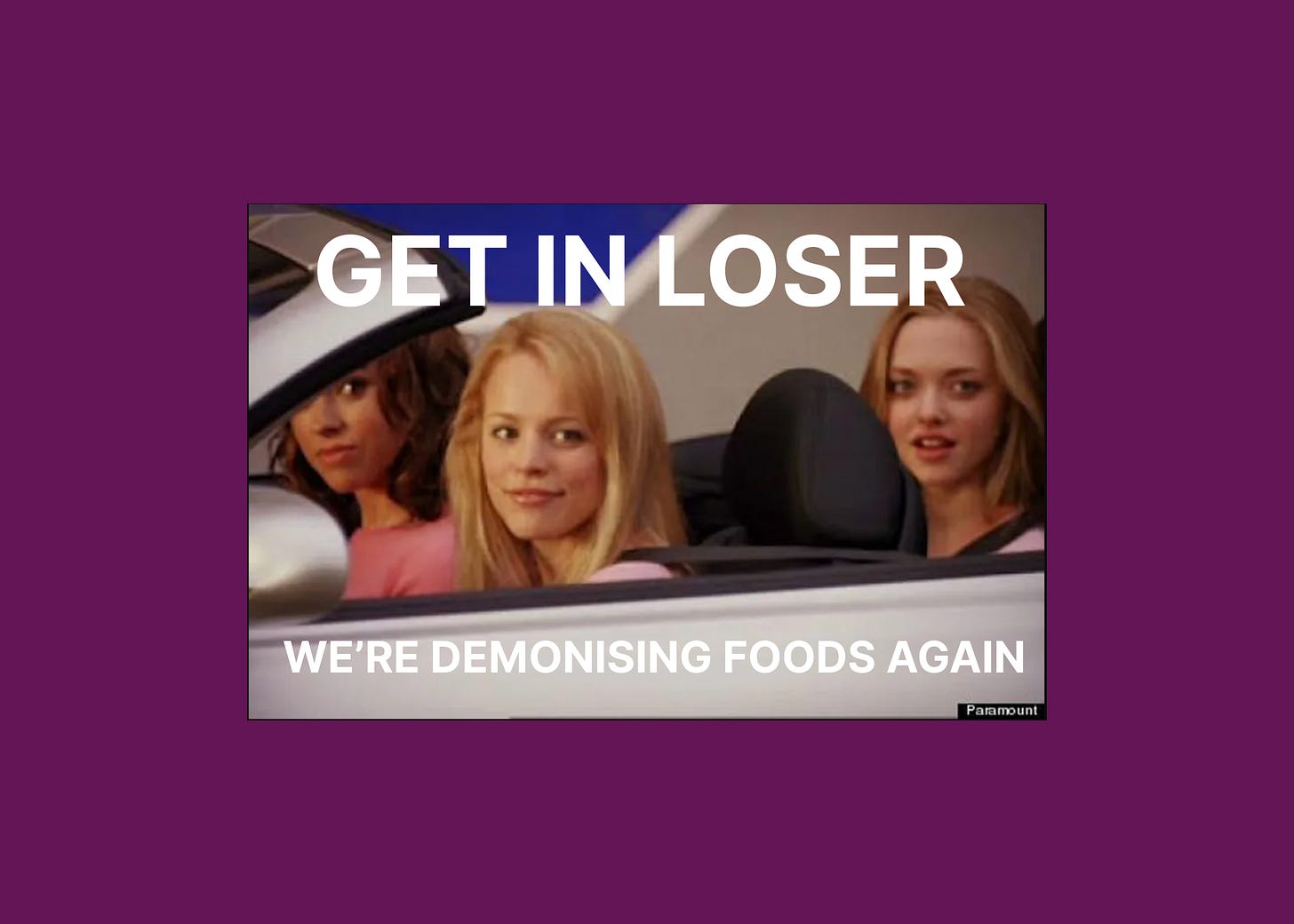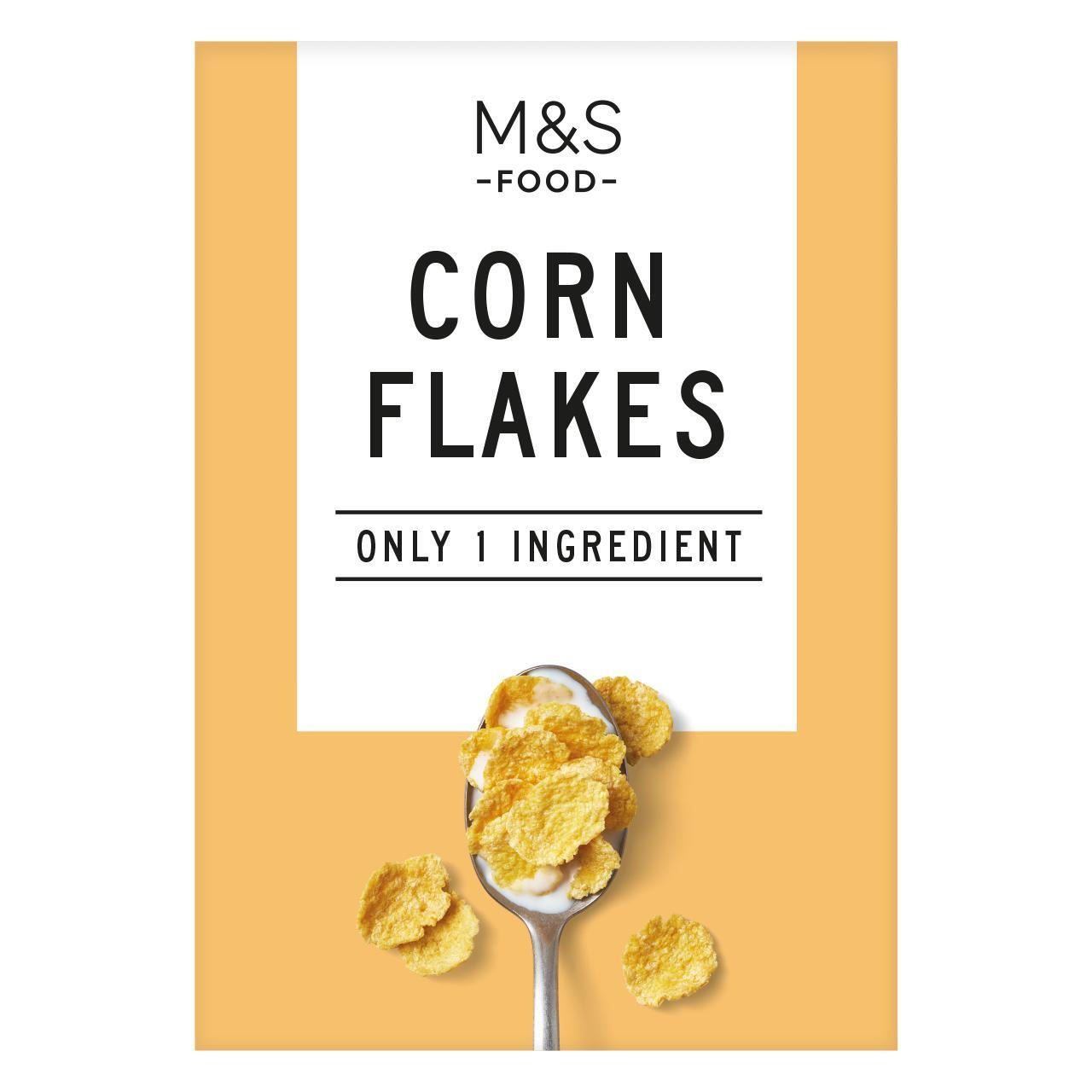Is ‘UPF’ just a new way of calling food ‘bad’?
get in loser, we're demonising foods again
Welcome back to Off the Scale!
Here, we ditch diet culture, question the latest nutrition fads, and, of course, throw away the scales.
Following the success of the number one best selling book, Ultra Processed People by Dr Chris Van Tulleken, it has become fashionable to cut out so called ‘ultra-processed foods’ (UPFs).
This newsletter will explore why myself and other nutrition professionals question whether the sweeping categorisation and avoidance of ‘UPFs’, is a helpful or healthy approach to nutrition.
Definition of UPF
According to the NOVA classification system ‘UPFs’ are a broad category of foods that have undergone multiple stages of processing. The presence of any additives that might extend shelf life, emulsify or fortify will instantly class a food as ‘UPF’.
This creates a huge group of different foods, all lumped together under this banner.
The important thing to recognise here, is that the categorisation is based solely on level of processing. The amount of processing a food has is not directly linked to how harmful or healthful it is.
Research around UPF highlights a correlation between level of processing and health outcomes. Correlation.
The ol’ Correlation vs Causation
Just because some UPFs are associated with poor health outcomes doesn’t mean it’s the processing that causes harm.
Many studies linking UPFs with negative outcomes do so at a population level, where high intakes often coincide with other factors, such as lower socioeconomic status, reduced access to healthcare, lower fruit and veg intake, and high consumption of sugar-sweetened beverages.
Not all UPFs are created equal. A fortified breakfast cereal isn’t the same as a monster energy drink, even if they both fall into the same category.
Don’t tar me with that brush!
The UPF label is like casting a wide net and blaming all the fish.
When we look more closely, the health concerns tend to come from high intake of specific products, in particular, those high in added sugars, saturated fats, and salt…
You know, the ones we already knew about.
I was around a dinner table recently where someone chided their partner for choosing processed margarine benecol, in favour of ‘real butter’ because it’s less processed.
Except… that spread, despite being ‘UPF’, has actual evidence supporting its cholesterol-lowering effects, and we know that butter, even though less processed, is not the best option for those with raised LDL.
When we tar all foods in the UPF category with the same brush, it doesn’t always lead to the healthiest choices.
This confusion doesn’t help anyone. We can’t expect people to read and interpret academic papers in between the school run and a full day of work.
And when healthy eating becomes too complicated or rigid, we know people are less likely to stick with it.
One bowl of cereal, skip the micronutrients please
The popularity of wanting to avoid UPF has lead Marks and Spencers to release a range of low-ingredient, UPF- free breakfast cereals.
Manufacturers have skipped adding vitamins and minerals because, under the NOVA classification system, the addition of isolated nutrients counts as ultra-processing.
Fortification of breakfast cereals is one of the most accessible and effective public health strategies for reducing nutrient deficiencies across the population.
According to the UK National Diet and Nutrition Survey (NDNS), breakfast cereals are one of the top contributors of iron and folic acid in children’s diets.
This is a backwards step for the health of the population.
Is ‘UPF’ just a new way of calling food ‘bad’?
Let’s be honest: for many people, the term ‘ultra-processed’ has become synonymous with bad.
When we label foods as ‘bad’, we assign them moral value. This creates guilt and shame when those foods are eaten, which can fuel disordered eating and emotional distress.
We have research that shows how labelling foods bad, leads to increased mental focus on those foods. This paradox is sometimes called the “forbidden fruit effect”. When we tell ourselves we ‘shouldn’t’ have something, we want it more.
When foods are moralised, people are more likely to adopt an all-or-nothing mindset around eating. This makes it harder to build consistent, realistic habits that actually support long-term health.
As a dietitian, I am concerned about fear based messaging when discussing food. I see many clients terrified of having any UPF at all, viewing them as poison. Children are impacted by this messaging too.
UPF: a conspiracy theory
If you pay attention to the narrative around ‘UPF’ you’ll notice that it is tied up with a conspiracy theory.
That UPFs are intentionally engineered to be addictive
as if food scientists are out here cooking up chemical compounds to hijack our brains and turn us into UPF-loving zombies.
While some foods do stimulate dopamine (our brain’s reward system), this doesn’t make them addictive in the same way substances like nicotine or alcohol are.
What stimulates dopamine is characteristics we’ve evolved to enjoy:
High fat
High sugar
Smooth, soft, or “melt-in-the-mouth” textures
Energy density
Pleasant aromas and flavours
These features are found in some UPFs, but they’re not exclusive to them, and not all UPFs even have these features.
Wholemeal sliced bread or fortified breakfast cereal may technically be “ultra-processed” under the NOVA classification, but they don't necessarily light up our reward system in the same way a chocolate bar might.
If you read my piece on food noise last week, you’ll know that eating for pleasure is not inherently bad for us.
Processing serves many legitimate purposes:
Extending shelf life (which reduces food waste and feeds more people)
Fortifying with essential nutrients (like iodine in salt or B12 in plant milks)
Making foods safer (pasteurised milk, anyone?)
Reducing cost and cooking time
Instead of assuming all processed foods are sinister, let’s recognise that they do play a key role in modern food systems, and in improving access to nutrition. They don’t need to be feared.
So… what do you suggest?
Here’s what might actually make a difference:
Ditch the labels. Let’s stop categorising foods as good or bad based on how many steps they went through in a factory. It’s not helpful.
Everyone has individual needs, for many of my clients adding high energy density processed foods is helpful for their health and recovery. For the general public, most people would benefit from more plants, more fibre, more variety.
Support access. That means fruit and veg vouchers, free school meals, food education in schools.
I like to promote nutrition by addition, not subtraction. Instead of completely cutting out certain foods, let’s think about adding beneficial ones, small steps like using fresh herbs or seeds as a garnish on a meal, adding an extra portion of veg that you like, and having more water can really help.
Final thoughts
I’m not saying we shouldn’t be critical of our food system.
We absolutely should.
But the UPF label isn’t the solution, it just adds confusion and guilt, where we need clear information, and helpful encouragement.
Thank you for reading, I recognise that for many people, what I have said here might challenge how you feel towards UPF. I’ll meet you in the comments section, open minds and hearts please <3
You are invited to our event next week
Body & Food: Healing the Relationship with Body Image Skills
Date: 15/04/2025
Time: 6pm
Location: Video conferencing
Remember that paid subscribers to Off the Scale are able to access the recordings to this workshop and our back catalogue of ones we have put on in the past.





